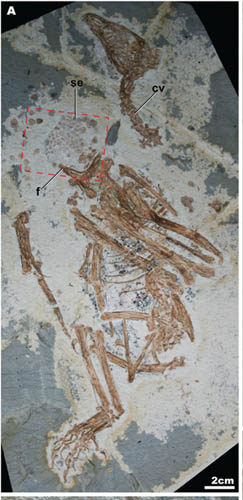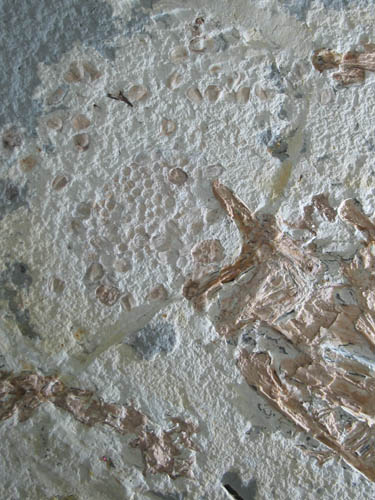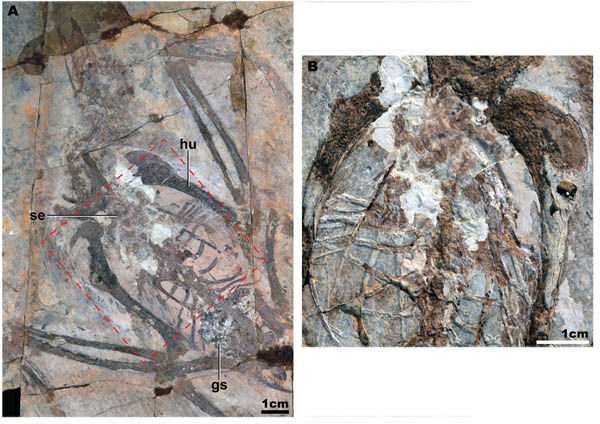Early Cretaceous Birds with Crops Found in China
The crop is characteristic of seed-eating birds today, yet little is known about its early history despite remarkable discoveries of many Mesozoic seed-eating birds in the past decade. Scientists from Institute of Vertebrate Paleontology and Paleoanthropology (IVPP), Chinese Academy of Sciences, Tianyu Museum of Nature in Shandong Province, China, and University of Kansas, USA, reported the discovery of some early fossil evidence for the presence of a crop in birds in the Proceedings of the National Academy of Sciences USA online today (Sep 5th, 2011). Two Early Cretaceous birds, the basal ornithurine Hongshanornis and a basal avian Sapeornis, demonstrate that an essentially modern avian digestive system formed early in avian evolution.
In modern seed-eating birds the crop provides storage, so that a number of seeds can be gathered quickly and then processed later in a more secure location without interference from competitors and/or predators. The mucus in the crop softens hard seeds so that they are more easily ground by the gizzard. The gizzard may be a more basal feature for birds, because it is widely distributed in sister groups, such as modern crocodilians. In recent birds the gizzard is posterior to the proventriculus or glandular part of the stomach. The practice of collecting large numbers of small stones in the gizzard is characteristic of seed eaters among modern birds and is often correlated with a well-developed crop.
In extant birds a crop is a ventral pouch of the esophagus and is situated anterior to the shoulder girdle just in front of the furcula. In fossils its position is indicated by a roughly spherical mass of seeds that is easily discriminated from stomach contents by its location outside of the ribcage.
“Despite the discoveries of more than 30 genera of fossil birds from the Early Cretaceous lacustrine deposits in northeastern China and many examples of dietary adaptations, it remains unknown whether a crop was present in these birds. Recently we examined hundreds of Early Cretaceous birds housed at the Tianyu Museum of Nature in Shandong Province, China, and found several specimens belonging to two taxa with unequivocal evidence of crops”, said ZHENG Xiaoting, lead author and director of Shandong Tianyu Museum of Nature, China, “One of them is Sapeornis, one of the basal birds presumed to have an herbivorous diet, and the second taxon is the basal ornithurine Hongshanornis. Both have preserved seeds in the anatomical location of the crop in extant birds. In some cases, even the soft tissue outline of the crop can be observed and resembles closely the structure in modern birds.”
The discovery of a crop in two phylogenetically remote lineages of Early Cretaceous birds and its absence in most intervening forms indicates that it was independently acquired as a specialized seed-eating adaptation.
"The discovery of a crop in two phylogenetically separate avian lineages opens a window for our understanding of dietary adaptation in the early avian radiation and may also help us better understand the great diversity in the Early Cretaceous, which occurred approximately 20 million years after the earliest bird, Archaeopteryx”, said Dr. ZHOU Zhonghe, correspondence author and research designer, Institute of Vertebrate Paleontology and Paleoanthropology (IVPP), Chinese Academy of Sciences.
"A number of other Mesozoic birds and their theropod relatives have recently been reported with gizzard stones (gastroliths), including the basal ornithurines Yanornis and Archaeorhynchus, the oviraptosaur Caudipteryx, and the ornithomimosaur Shenzhousaurus, confirming that the presence of a muscular grinding stomach is primitive for birds. It may well have occurred in most species but is only documented in forms that foraged on the ground and thereby came into contact with small stones. The discovery of crops in combination with stomach stones demonstrates the presence at an early date of an essentially modern avian digestive system”, said Dr. Larry D. Martin, coauthor, Biodiversity Institute, University of Kansas.
All birds from the beginning of the Cenozoic are toothless. Although reduction of body weight has often been cited as an important factor for reduction or loss of teeth in birds, scientists believe the dietary adaptation was probably an equally if not more important factor in early avian evolution. Both avian taxa that preserved the evidence of a crop have either largely reduced teeth or have completely lost their teeth. The basal avian Sapeornis has partially reduced teeth, whereas the early ornithurine Hongshanornis has completely lost its teeth and is one of only few known toothless genera among Mesozoic ornithurine birds. Most ornithurine birds from this period seemed to have been water marginal and used small pointed teeth to capture small arthropods and fish.
The apparent link between the appearance of crops or gizzards or both and the loss of teeth across phylogenetic lineages suggests that granivory was probably one of the factors in the reduction of teeth in early birds. “It should also be noted that many raptorial birds like hawks and nectivorous birds like hummingbirds also have a crop. In these cases the crop does not seem to be linked with granivory. Unless we have more evidence about the distribution of the crop with diets in early birds, it is premature to argue that seedeating was necessarily the driving force for the origin of the avian crop; however, the current known evidence seems to suggest that seed-eating was at least an important factor in early avian evolution”, said ZHOU Zhonghe.
This research was mainly supported by the National Basic Research Program of China (973 Program), the National Natural Science Foundation of China, and the Chinese Academy of Sciences.

Fig.1: Photograph of Sapeornis chaoyangensis housed at the Tianyu Museum of Nature with preservation of a crop.(Image by IVPP)

Fig.2: Close-up view of seeds at the crop region in the skeleton of Sapeornis chaoyangensis.(Image by IVPP)

Fig.3: Photographs of an ornithurine Hongshanornis longicresta (Left) and close-up view of the seeds belonging to crop and the gizzard stones.(Image by IVPP)

Download attachments: